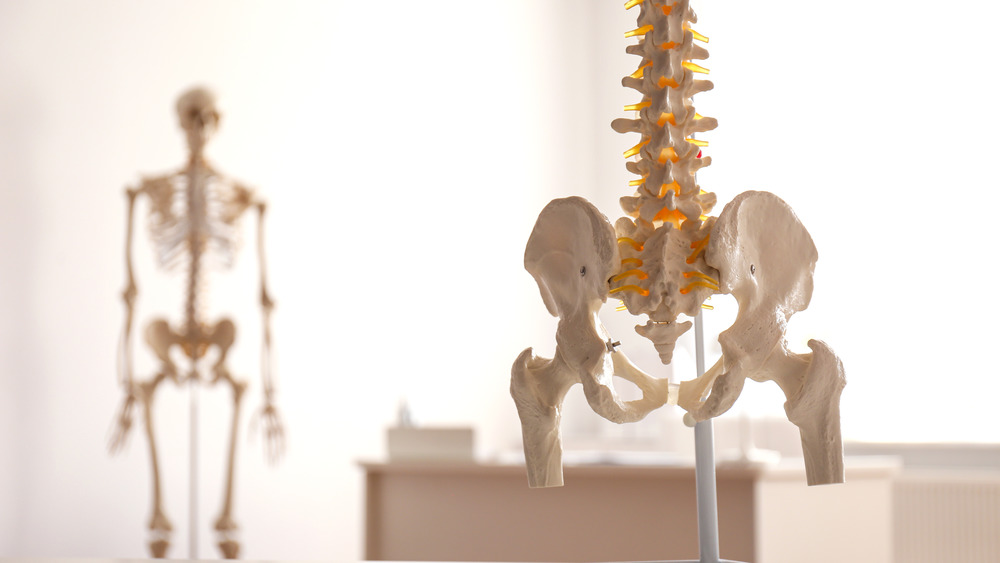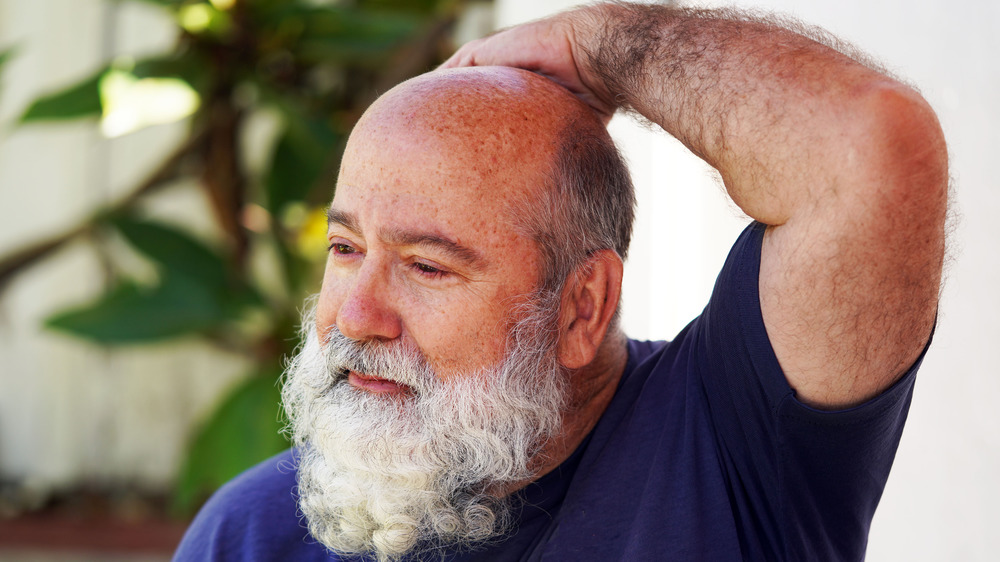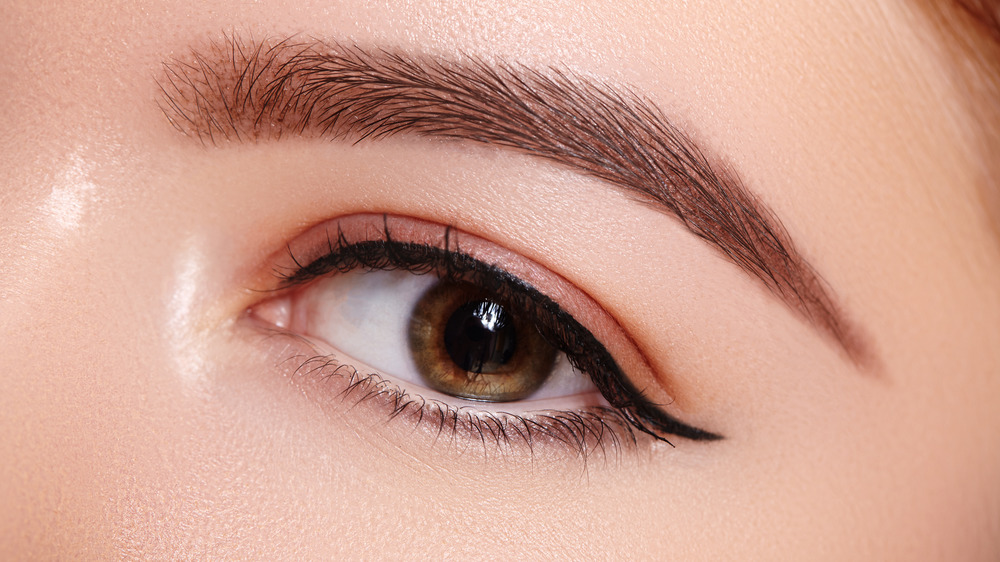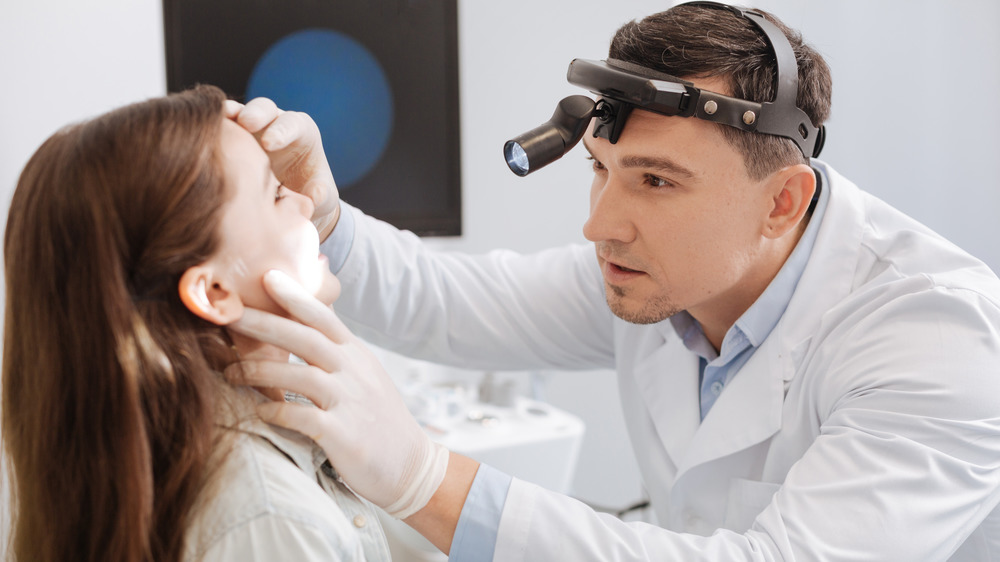Body Parts That Humans Don't Actually Need Anymore
The average human body has evolved to be both taller and fatter in the past century, a 2017 study by the University of Cambridge found. Go back a couple thousand years, and you'll find that those changes are even more pronounced, and other changes have occurred as well.
In the last two to three millennia, the average female pelvic circumference has increased, as has the average size of a newborn baby's head, explained a report in The Anatomical Record. And according to a 2016 study out of Stanford University published in the journal Science, more people are blonde, more people are lactose intolerant, and insulin levels have gotten higher overall.
Our species, known as homo sapiens, is just the latest iteration of humanity, which is believed to have originated millions of years ago (via The Atlantic). Granted, we look a lot different from the first species that scientists qualify as human. But that's just what you can see. Beneath our skin are body parts that were vital for survival for the earliest species of human, but which now play little to no part in human survival. Let's take a look at all the body parts humans don't actually need anymore.
You don't actually need your tailbone
Most animals have tails, according to Spine-health. They use this part of their body for balance, forward propulsion (including for purposes of getting away from predators), and communication, among other things, according to the BBC's science magazine, Science Focus. But as humans evolved, natural selection – the process through which species evolve in order to survive in their environments — favored those who had increasingly smaller tails, because maintaining a tail that one doesn't use is just a waste of the body's energy. Today, humans appear to be completely tailless, but that's not entirely true.
Humans are still born with a tail of sorts, physician Leann Poston confirmed to Health Digest. What's left of the human tail is the coccyx bone, or what many of us refer to as the tailbone. It's a small, triangular-shaped bony terminus at the end of the spine.
You could live without your tailbone, as evidenced by the fact that tailbone removal is an accepted surgical treatment for correcting unrelenting lower back pain. However, it can still be good to have because it helps with balance, especially when sitting, moving, and eliminating waste (it supports the anus), according to Dr. Poston.
Male nipples serve no purpose beyond the human embryonic stage
Yes, men, you can live without your nipples. However, you probably wouldn't be born without them. During the first weeks of gestation, all embryos follow the same androgynous "blueprint," as Ian Tattersall, a paleoanthropologist at New York City's American Museum of Natural History, told Live Science. And that includes nipples. Bodies that have the Y chromosome, which makes them genetically male, only begin developing male sex characteristics after about six to seven weeks gestation. That development goes only in one direction, however; it does not reverse the existence of male nipples. And so males are born with pretty purposeless nipples.
You could live without your nipples as a female too. After all, some women are born without them (a condition known as athelia) and mastectomies often involve removing the breast and nipple. Nevertheless, not having nipples makes nursing offspring impossible.
Most of your body hair has no real reason to be on your body anymore
Humans can survive without body hair. But that doesn't mean body hair serves no purpose, according to a 2011 paper published in the International Journal of Trichology. Body hair helped early humans regulate their temperature. It's also a buffer against injury to skin, including as a result of sun exposure. In addition, it retains scent quite effectively, helping to bring partners together to mate and propagate the species, according to Healthline and is connected with nerve fibers that allow our hair to communicate certain emotions, including fear (when our hair stands up on end).
As humans evolved, we became less hairy, as it was increasingly less advantageous to have all that hair everywhere. For example, an absence of body hair meant it would be more difficult for parasites to attach themselves to a human, according to Smithsonian Magazine. One notable exception is the hair that lines our nasal passages (cilia) which help filter out dirt and other foreign invaders. People without cilia or with cilia dysfunction face a number of health issues, including chronic upper respiratory infections, according to a 2012 paper published in the American Journal of Rhinology and Allergy.
You don't need hair on your head to survive
Our eyebrows help keep sweat from dripping into our eyes, according to the American Academy of Ophthalmology, which also noted that facial hair, including eyelashes, also helps protect the eyes from environmental threats. The hair in our ears and our noses helps do the same for our inner ears and respiratory systems, according to a 2012 paper published in the American Journal of Rhinology and Allergy. But for the most part, humans have evolved away from having furry bodies, as pointed out by Smithsonian Magazine.
So then why do we still have so much hair on our heads, relative to our bodies? A professor at Penn State attempted to answer this question in the blog for their course, Science in Our World. For one thing, the professor wrote, the hair on our heads helps insulate our bodies from the sun's heat and UV rays. For another, when we sweat, our hair retains water and thereby helps us cool down. But since hair is continuing to evolve, as demonstrated by this 2008 study published in BMC Evolutionary Biology, it could, one day, cease to exist.
The human body really has no need for pubic hair
Humans can very much survive without pubic hair. The human body has already lost much of its "fur" (both on the body and on the head) as we have evolved, according to Smithsonian Magazine. However, as "smooth" as humans have become, we do continue to sprout pubic hair. So why do we have it if we don't need it for the survival of our species?
Scientists theorize that pubic hair serves several purposes, including protecting the genitals from friction during sexual intercourse, helping keep the genitals at an optimal temperature for reproduction, and possibly acting as a visual signal that a potential partner in reproduction is sexually mature (i.e., capable of reproduction), albeit not ones that are vital to survival, according to Medical News Today. Additionally, Smithsonian noted that pubic hair serves the purpose of retaining the scent of pheromones secreted by the body parts it covers, so arguably, pubic hair may play some role in species propagation.
Your wisdom teeth don't make you wiser, and you don't need them for chewing
Humans are born with the blueprints for two sets of teeth, dentist Joel Gould told Health Digest. The first are 20 baby teeth, which we lose usually before puberty. The second are 32 adult teeth, four of which take more time to develop, much like wisdom. Known as "wisdom teeth," these four molars, located further back in the mouth than any others, come in after age 15, usually between 17 and 21, according to WebMD.
The early human diet was entirely raw — raw meat, raw vegetables, raw everything — which made the ability to grind up food essential for survival, according to dental surgeon Jenny Lane, writing for Biltmore Oral and Facial Surgery's website. The wisdom teeth helped add to our chewing power, and the human jaw was large enough to accommodate it back then. However, as humans evolved, food got softer (cooking helped), and we were aided by eating utensils, thus making chewing easier.
In response to a diminished need for stronger chewing power, the jaw grew smaller and less powerful as we evolved. Apparently, though, our wisdom teeth have not yet gotten the memo.
You can survive without your appendix, but the organ does serve a purpose
The role of the human appendix, a small worm-like protrusion attached to the large intestine, has been debated by scientists for many years, according to physician Leann Poston. That's because the human body can certainly survive without one, and its purpose is not readily obvious (via Live Science).
Some studies indicate the appendix may play some role in the development and function of the immune system, including in the development and maturation of antibody-producing cells called "B cells," Dr. Poston told Health Digest. Of course, there are also many instances in which the removal of the appendix can be life-saving, Dr. Amy Rodriguez, a surgeon at Wilcox Medical Center and Kauai Medical Clinic, pointed out to Hawaii Pacific Health, a healthcare system based in Hawaii.
Nevertheless, some scientists resist referring to the appendix "vestigial," which is science-speak for "no longer having any purpose" until its utter uselessness can be scientifically proven, a 2015 study published in the Journal of Clinical Diagnostic Research highlighted.
You have an extra eyelid that you could definitely live without
If you're a dog owner, perhaps you've noticed that your dog appears to be sleeping with its eyes open. However, in most cases, it's not that your dog's eyes are actually open, but rather that you can't easily discern that there is a thin membrane that is actually covering your dog's eyes. This eyelid, which moves across the eye horizontally (rather than vertically like the upper and lower lids), is known as the "nictitating membrane," according to the veterinary professionals at Safari Veterinary Care Centers. Its purpose is to offer extra moisture and protection for the eyes.
Humans have it too — or rather, a remnant of what was probably present in earlier species of humans, according to doctors Carol L. Shields and Jerry A. Shields, writing for Ento Key, a otolaryngology and ophthalmology research tool. In humans, that small fold of tissue located in the inner corner of the eye near the tear duct, which appears pink or red, is known as the "plica semilunaris," noted the doctors. And since it is no longer capable of covering the surface of the eye, it no longer serves any known purpose.
Compared to other organs, the vomeronasal organ isn't necessarily up to snuff
The vomeronasal organ is located in the lower part of the front of your nose, according to a 2018 research paper published in Cureus. It's present in a variety of mammals, amphibians, and reptiles. In such animals, it plays an important role in detecting subtle scents, including those of pheromones, according to Danish surgeon Ludwig Jacobson, who studied the organ extensively enough during the early 19th century that some refer to it as the "Jacobson Organ."
The thing is, Dr. Jacobson wasn't entirely convinced the vomeronasal organ existed in humans (although it had been identified in cadavers). And even in assuming it did, he certainly did not believe it played any useful purpose in human life and survival.
What is now understood about this organ is that it has a rich blood supply and contains cells that support the sense of smell. However, some studies, including a 2014 study in The Anatomical Record, suggest that this organ may have some purpose during human embryonic development, but no actual purpose once a human is born. Certainly, one can live without it, as evidenced by the fact that it can be removed without much apparent consequence, a 2004 study in Chemical Senses found.
You don't need your tonsils to survive
When you open up your mouth and say "ah," it helps your doctor to see more of the inside of your mouth, throat, and tonsils, which are the soft tissue masses located on either side of the back of your throat, according to the Mayo Clinic. Tonsils are part of the immune system, physician Leann Poston explained to Health Digest, in that they filter disease-causing pathogens as we breathe and eat. They also offer white blood cells information in the form of antigens to help them produce antibodies specific to those antigens.
Nevertheless, doctors remove the tonsils of more than 500,000 children each year in the U.S. alone, according to the American Academy of Otolaryngology. That's because removal of the tonsils can actually reduce the number of sore throats and throat infections a child gets, otolaryngologist Jonathan Swart revealed in a post for the Vancouver Clinic. That said, a large-scale 2018 study published in JAMA Otolaryngology-–Head & Neck Surgery suggests that removal of tonsils in childhood may be associated with of a significantly increased risk of respiratory illnesses in adulthood. Still, you can certainly live without your tonsils.
Your adenoids (if you still have them) are pretty much redundant
The adenoids are located behind the nose, higher up in the throat than the tonsils, but they have a similar function, physician Leann Poston told Health Digest. They support the immune system by physically blocking pathogens and providing information on those pathogens to white blood cells to help them produce antigens against those pathogens. But like the tonsils, the purpose the adenoids serve is not vital or unique, and doctors routinely remove them when they become infected or are otherwise enlarged, according to the Cleveland Clinic.
In children whose adenoids are not surgically removed, the adenoids tend to shrink between the ages of five and seven, and may fully disappear by the time the child reaches the teenage years, the Cleveland Clinic noted. Still, a 2018 study published in JAMA Otolaryngology–Head & Neck Surgery, which followed 1.2 million children after having their tonsils and/or adenoids removed, indicated that such removal may be linked to a higher risk of upper respiratory infections in adulthood.
It's good to have a spleen, but it's not absolutely necessary
Tucked behind your ribcage in the upper left-hand side of your abdomen is your spleen, a smallish (usually fist-sized) organ that supports your immune system by filtering old, abnormal, or damaged red blood cells out of your circulatory system, according to the MIT News. It also produces lymphocytes (a type of white blood cell) to fight off infections that it detects as it filters your blood. While your spleen serves an important purpose, you can certainly live without it, according to physician Leann Poston.
In fact, some people are born without a spleen, a condition known as asplenia, which also refers to people who have a malfunctioning spleen or who have had their spleen removed due to illness or injury. In people with asplenia, the lymph nodes and liver take over for the spleen. Not having a spleen puts you at increased risk for more serious pneumonia and meningitis bacterial infections. However, the risk can be mitigated with vaccinations, according to Healthline.
Your body doesn't actually need a gallbladder to live
The gallbladder plays an important role in food metabolism in that it stores bile, the greenish-yellow digestive compound produced by the liver to aid in digestion, especially of fats and foods high in fiber, physician Leann Poston told Health Digest. But the gallbladder is not vital to survival because bile can go straight from the liver to the small intestine, wrote surgeon Johnny L. Serrano on the website he maintains for his practice, Precision Surgery and Advanced Vein Therapy.
In fact, many people live without a gallbladder, according to Dr. Serrano. Gallbladder removal is known clinically as cholecystectomy, according to the American Cancer Society. People who have had a cholecystectomy can live normal lives as long as they are willing to cut out the foods that are most difficult to digest without a gallbladder, according to Healthgrades. These include foods high in fat and foods high in fiber.
You don't need this forearm muscle, and you might not even have it
If you clench your fist tightly and look at the inside of your wrist, you'll probably see a small network of veins, according to American Society for Surgery of the Hand. What you may or may not see, however, is a ropey protrusion running lengthwise up and down your wrist, which is called the palmaris longus muscle. It helps with wrist flexion and grip strength (via Physiopedia).
However, the complete absence of the palmaris longus (aka palmaris longus agenesis) in a large number of people on the planet these days suggests we have evolved away from actually needing it in our modern lives, a 2015 study published in the Journal of Clinical Medicine Research explained. Interestingly, palmaris longus agenesis is more common in some countries than in others, with it being least common in Zimbabwe and most common in Turkey (nearly 64 percent of the Turkish are living without this muscle, according to the study).















